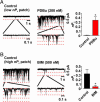Constitutively active L-type Ca2+ channels
- PMID: 16040810
- PMCID: PMC1180225
- DOI: 10.1073/pnas.0500360102
Constitutively active L-type Ca2+ channels
Abstract
Ca(2+) influx through L-type Ca(2+) channels (LTCCs) influences numerous physiological processes ranging from contraction in muscle and memory in neurons to gene expression in many cell types. However, the spatiotemporal organization of functional LTCCs has been nearly impossible to investigate because of methodological limitations. Here, we examined LTCC function with high temporal and spatial resolution using evanescent field fluorescence microscopy. Surprisingly, we found that LTCCs operated in functionally organized clusters, not necessarily as individual proteins. Furthermore, LTCC function in these clusters does not appear to be controlled by simple stochastic gating but instead by a PKC-dependent switch mechanism. This work suggests that resting intracellular free calcium concentration in arterial myocytes is predominantly controlled by this process in combination with rare voltage-dependent openings of individual LTCCs. We propose that Ca(2+) influx via persistent LTCCs may be an important mechanism regulating steady-state local and global Ca(2+) signals.
Figures




References
-
- Fish, R. D., Sperti, G., Colucci, W. S. & Clapham, D. E. (1988) Circ. Res. 62, 1049-1054. - PubMed
-
- Deisseroth, K., Heist, E. K. & Tsien, R. W. (1998) Nature 392, 198-202. - PubMed
-
- Dolmetsch, R. E., Pajvani, U., Fife, K., Spotts, J. M. & Greenberg, M. E. (2001) Science 294, 333-339. - PubMed
-
- Nishiyama, M., Hoshino, A., Tsai, L., Henley, J. R., Goshima, Y., Tessier-Lavigne, M., Poo, M. M. & Hong, K. (2003) Nature 423, 990-995. - PubMed
Publication types
MeSH terms
Substances
Grants and funding
LinkOut - more resources
Full Text Sources
Other Literature Sources
Miscellaneous

